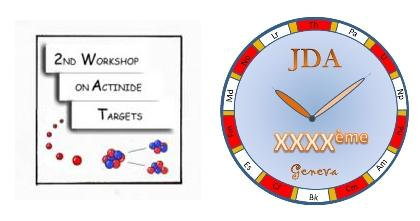Speaker
AHMET OZGUMUS
(Institut de Physique Nucléaire d’Orsay, UMR 8608 CNRS, Université Paris-Sud 11, Orsay)
Description
Very recently studies have been started at IPNO within the framework of the SPIRAL2 project to optimize the properties of uranium carbide used as a fission target. The required characteristics of this target are both the high fission production yield and the capability to release the fission products outside the material as fast as possible. The method of production of this material must be safe and reproducible. The method must allow to control various properties such as the stoichiometry, the density, the size of the pore and their connectivity, the mechanical resistance to swelling during irradiation and the thermal stability. Through the studies we are undertaking, the objective is to get an in depth understanding of the properties of the uranium compounds as a function of the synthesis parameters and also of their behaviour under operating conditions: high temperature and high irradiation dose. Our studies concern three ways of synthesis: the first two methods are the carbo-thermic reductions of a mixture of uranium oxide and uranium oxalate and graphite at high temperature [1-4]. The third way is the synthesis by fusing a stoichiometric mixture of metallic uranium and graphite into an electrical arc [5]. Most of the important characteristics detailed above are controlled by dependant parameters like synthesis and sintering temperatures and durations. Because of the drastic conditions of use, all these characteristics could change. High temperature and high irradiation dose will modify considerably the initial properties of the material and could lead to the collapse of the material by swelling, polygonization or amorphization [6-11].
Our first studies show that we are able to well-control the stoichiometry of the material (monocarbide UC or dicarbide UC2) determined by the X-Ray diffraction measurements. We can also control the density ranging from 3.5 g.cm-3 to 13.2 g.cm-3 (25% to 97% of the theoretical density of UC). The density is determined by helium pycnometry. The control of the grain size ranging from 1 to 30 µm (measured by Scanning Electron Microscope) and also the control of the size and the distribution of the pore size (measured by mercury porosimetry) are in progress. The target release properties will be performed by comparing the quantity of radio-nuclides present in irradiated pellets before and after heating by gamma-spectrometry. The behaviour of the most interesting targets obtained will be studied under high temperature and high irradiation dose. The kinetic of the closing of the pores and the evolution of the mechanical strength of the pellet during long term operation will also be studied.
Author
AHMET OZGUMUS
(Institut de Physique Nucléaire d’Orsay, UMR 8608 CNRS, Université Paris-Sud 11, Orsay)
Co-authors
Botoum Hy
(Institut de Physique Nucléaire d’Orsay, UMR 8608 CNRS, Université Paris-Sud 11, Orsay)
Brigitte Roussière
(Institut de Physique Nucléaire d’Orsay, UMR 8608 CNRS, Université Paris-Sud 11, Orsay)
Christophe Lau
(Institut de Physique Nucléaire d’Orsay, UMR 8608 CNRS, Université Paris-Sud 11, Orsay)
Evelyne Cottereau
(Institut de Physique Nucléaire d’Orsay, UMR 8608 CNRS, Université Paris-Sud 11, Orsay)
Henri Noël
(Sciences Chimiques de Rennes, UMR CNRS 6226, Université de Rennes 1, 263 Avenue de Général Leclerc, Rennes F-35042, France)
Maher Cheikh Mhamed
(Institut de Physique Nucléaire d’Orsay, UMR 8608 CNRS, Université Paris-Sud 11, Orsay)
Mathieu Pasturel
(Sciences Chimiques de Rennes, UMR CNRS 6226, Université de Rennes 1, 263 Avenue de Général Leclerc, Rennes F-35042, France)
Nicole Barré-Boscher
(Institut de Physique Nucléaire d’Orsay, UMR 8608 CNRS, Université Paris-Sud 11, Orsay)
Olivier Tougait
(Sciences Chimiques de Rennes, UMR CNRS 6226, Université de Rennes 1, 263 Avenue de Général Leclerc, Rennes F-35042, France)
Said Essabaa
(Institut de Physique Nucléaire d’Orsay, UMR 8608 CNRS, Université Paris-Sud 11, Orsay)
